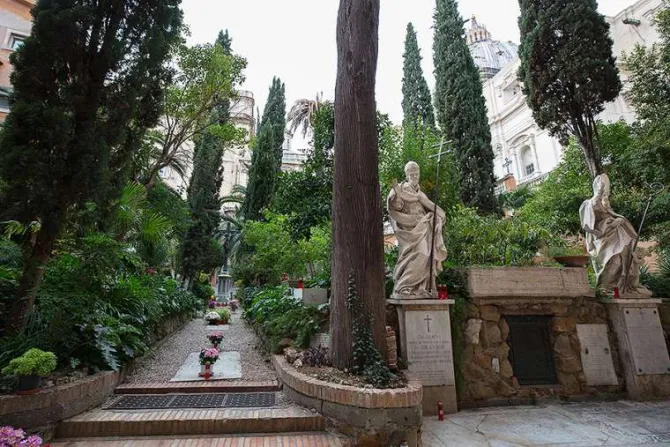Vatican City, Jul 22, 2019 / 18:00 pm
The search for the remains of missing 15-year-old Emanuela Orlandi took another twist as Vatican officials discovered "thousands" of human bones in a previously unknown ossuary on Saturday. It is unclear if any of the bones belong to Orlandi, or how old they are.
On July 11, the Vatican opened two tombs belonging to Princess Sophie von Hohenlohe and Duchess Charlotte Frederica of Mecklenburg-Schwerin, who both died in the mid-19th century. The tombs, located in the cemetery of the Teutonic College, adjacent to the Vatican City State, were found to be completely empty of any human remains. Scientists were initially puzzled by this unforeseen development.
Afterwards, Vatican officials realized that restoration and structural work done in the 1960s and 1970s likely resulted in remains being moved. This led to the discovery of two ossuaries underneath the Teutonic College, which held containers of bones. Ossuaries are container, or even rooms, used to store skeletal remains after the rest of the body has decomposed. They are common in areas where underground burial space is limited.
Members of Orlandi's family, as well as their lawyer and a forensic expert, were present at the opening of the containers.
Orlandi's sister, Frederica, described the opening as an "emotional experience" and thinks that Emanuela's remains are possibly in the ossuary.
Her brother, Pietro, described the discovery as "a large number of diverse bones," and noted the need to identify and date the remains. Giorgio Portera, a forensic expert working with the family, estimated the total number of bones found indicated "the presence of the remains of a few dozen people."
"There are long bones, small bones, many are fragmented," said Portera. He explained they were not sorted, and were mixed together "all piled up inside a cavity."
There are 206 bones in an adult body, meaning that the partial remains of a handful of people could easily number over 1,000 bones.
According to Vatican spokesman Alessandro Gisotti, there will be "an in-depth morphological analysis" of the bones within the next week. Gisotti said that international protocols were followed during the initial examination of the bones.
Orlandi disappeared in Rome on June 22, 1983, and has not been seen or heard from since--although there have been several unconfirmed sightings. Prior to her disappearance, Orlandi called her sister and told her that she was approached by a man in a BMW who offered her a job selling Avon cosmetics. This man has never been identified. Orlandi's father worked in the Vatican, and she and her family are citizens of Vatican City State. The Vatican denies having any role in her disappearance, but conspiracy theories regarding her disappearance have run rampant in Italy since she first vanished.
Almost two weeks after she disappeared, St. Pope John Paul II mentioned her in the Angelus, and asked for her those responsible for her disappearance to come forward. Shortly after this, her family began receiving telephone calls from people claiming to be associated with Turkish nationalist groups, claiming to have kidnapped Orlandi as a bargaining chip to secure the release of Mehmet Ali Ağca.
Ağca, who attempted to assassinate St. Pope John Paul II in 1981, said in an interview with Italian television that he believed Orlandi was alive and well and living in a convent. In 2006 he again stated that Orlandi is living in a cloistered convent somewhere in Europe. This has never been confirmed.
Others speculate that the Italian mafia was involved in her disappearance, or that she was kidnapped on the order of a cleric to send a message to her father.
Physical remains can be dated using carbon testing, which tests for the half-life of carbon. An older bone would have less carbon than a newer bone, which can provide a ballpark estimate for how old something may be.



